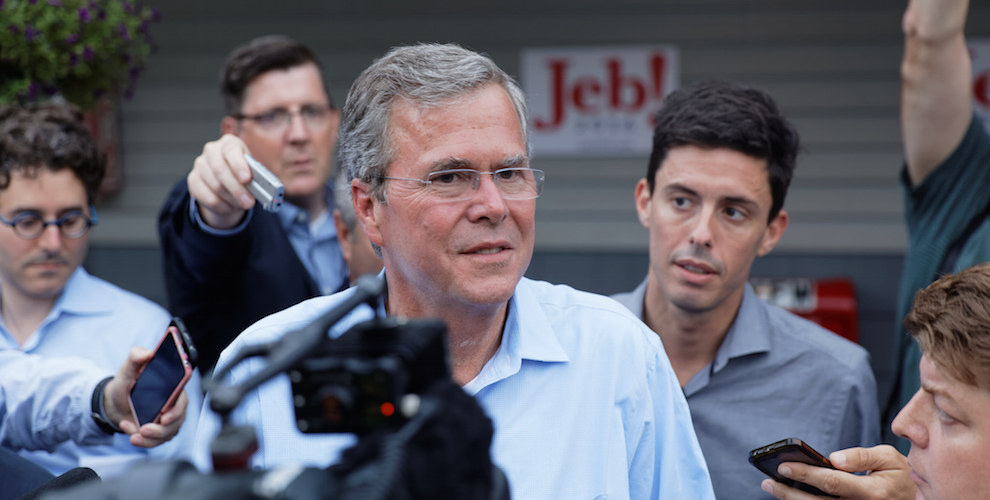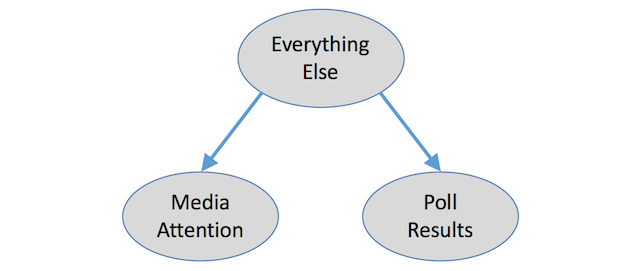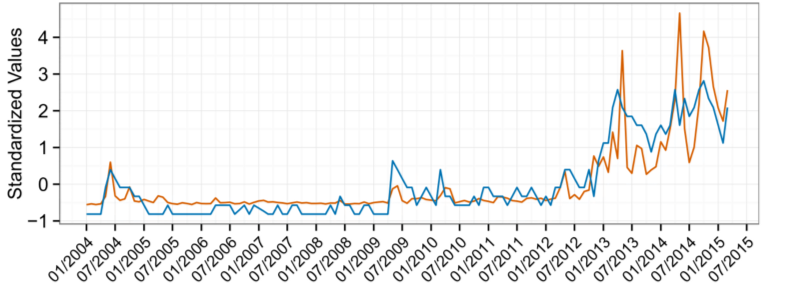
Whether your favorite candidate is popular or unpopular, it’s always popular to blame the media. We see a lot of this right now in discussions of why Trump is in the lead or why Sanders isn’t.
Usually the complaints have to do with what the media is saying about a candidate. But another theory says that it’s the attention that matters. Good news or bad — maybe the important thing is just to be talked about.
Or maybe professional journalists have very little influence at all. Many people now get their news by clicking on articles from social media, where your friends and a filtering algorithm decide what you see.So does the media still matter? Does attention get results for candidates, regardless of what is said? And if it does, how should journalists cover elections fairly and responsibly? These are the questions I wanted to try to answer, at least as they relate the current U.S. presidential primaries.
These are big questions about how the American political system works, far too big for simple answers. But you have to start somewhere, so I decided to compare the number of times each 2016 candidate has been mentioned in the U.S. mainstream media with their standing in national primary polls. To my surprise, the two line up almost exactly.

Percentage of online media mentions and percentage primary voters supporting each candidate, Q4 2015. Source.
This chart shows the number of times a candidate’s full name appeared in the top 25 online news sources, as a percentage of all mentions, for October to December of 2015. (Republican candidates were mentioned about twice as often as Democratic candidates overall, but this chart compares each candidate to the others within their party.) There’s an uncanny agreement between the media attention and each candidate’s standing in national primary polls. It’s a textbook correlation.
Depending on what corner of the political universe you come from, it may surprise you to learn that both Trump and Sanders were covered in proportion to their poll results — at least online. Pretty much everyone was. The exceptions are Jeb Bush, who seems to have been covered twice as much as his standing would suggest, and Carson, who might have been slightly under-covered.
By simply counting the number of mentions, we’re completely ignoring what journalists are actually saying, including whether the coverage was positive or negative. This data doesn’t say anything at all about tone or frame or even what issues were discussed. All of these things might be very important in the larger context of democracy, but they seem to be less important in terms of primary poll results. While the story surely matters, it doesn’t seem to matter as much as the attention. In particular, Trump has received much more negative coverage than his GOP competitors, to little apparent effect.
I admit I was a bit shocked to discover how closely the percentage of media mentions and the percentage of voter support align. But I’m also not the first to notice. Nate Silver found that this pattern holds in U.S. primary elections going back to 1980, though his model also incorporated favorability ratings. This correlation has also been noticed by previous political science researchers, though I haven’t been able to find anywhere it’s been seriously investigated.
So what’s going on here? How do all the numbers on this chart just line up? Does this mean the media exert near-total control over the political process? Fortunately, no. To begin with, national primary polls don’t predict the eventual nominee very well; state polls matter much more, because the nominating process happens one state at a time. But it seems reasonable to imagine that media attention has some effect on the polls. Yet journalists also respond to the polls, which means it isn’t clear what’s causing what.
If you’re worried about the media’s influence you’re thinking of a causal relationship like this:

But there are two other ways that these variables can become highly correlated. First, causality could go the other way. The polls could drive the media.

This isn’t completely insane. Journalists have to follow audience attention or risk getting ignored. And if voters are also readers, a candidate who is twice as popular might get twice the number of views and shares. That matters when you’re deciding what to cover — though it’s hardly the only consideration. More on that later.
There’s one more way to get a close relationship between media and polls: something else could be driving both of them. For example, attention on social media could drive both. A single post can go viral and reach millions without any involvement from professional journalists. Or perhaps endorsements from famous people and organizations are the key to influence, as political scientists have long suspected. And then there are the candidates themselves: anything they do might make them more (or less!) favorable with both the media and the public. In short we need to consider every other thing, and many of these things will drive media attention and voter preference in the same direction, causing a correlation like the one we’ve seen.

These are the basic causal forces, the only possible ways that media attention and polling results can become so closely aligned. We’re going to need more information to figure out what is causing what.
One way to test for causality is to ask whether a change in coverage precedes a change in the polls, or vice versa. Here’s the number of articles mentioning the right-wing U.K. Independence Party (UKIP) versus poll results, tracked over 11 years in the British press.

Number of articles mentioning UKIP (orange) versus percentage who say they would vote for UKIP (blue). From Does Public Support for UKIP Drive Media Coverage or Does Media Coverage Drive Support for UKIP by James Murphy.
In this chart by James Murphy of Southhampton University, we’re looking at changes across time, rather than between parties. Yet once again, coverage and popularity follow each other closely. To determine which came first, Murphy built a statistical model that tries to predict this month’s polls from the previous month’s coverage, and vice versa. Whichever direction works better, that’s the way the cause runs. But the results were inconclusive — they depended on exactly how the model was put together. This suggests that the causality goes both ways.
Here’s a similar chart of popularity and coverage over time for Trump:

Weekly online media mentions of Trump vs. national primary polls. Source.
Trump’s polls and mentions rose at about the same rate after he announced his candidacy, so at first glance it looks like the two are tied together. But media spikes don’t always translate into polling spikes: Both debates produced a spike in coverage, but the polls actually decreased in the short term. The burst of coverage after he announced his plan to exclude Muslims does seem to line up with a bump in popularity, though.
John Sides of George Washington University has done a statistical analysis to try to tease out the causality in Trump’s data and, once again, the results don’t clearly favor the chicken or the egg. Instead, it seems that the media and the polls drive each other loosely. Most of the other candidates show the same general pattern.

Weekly online media coverage of candidates vs. national primary polls. Source.
We typically see a rise after the candidate announcement, then general agreement with the level of media coverage even though the peaks don’t line up. Clinton seems to be the exception: Her popularity seems to have less to do with coverage volume than any other candidate. Maybe that’s because we’ve known for a very long time that she was going to run, and we should really plot this chart back another year or two.
My sense is that what we have here is a feedback loop. Does media attention increase a candidate’s standing in the polls? Yes. Does a candidate’s standing in the polls increase media attention? Also yes. And everything else which sways both journalists and voters in the same direction just increases the correlation. The media and the public and the candidates are embedded in a system where every part affects every other.

It’s all of these forces acting in concert that tend to bind media attention and popularity together. It’s not that media attention has no effect — we have good reason to believe it does, both from this data and from other research. It’s just that the media is not all powerful, despite what the close correlation suggests.
Faced with the awesome ability to influence the outcome of an election just by drawing attention to a candidate, how should the media cover an election?
No editor is sitting there saying: Hey, Cruz gained five points, let’s cover him 5 percent more. But journalists do respond to audience attention. Reporters and editors are driven by lots of different demand signals, such as how many people read yesterday’s article about a candidate, or how many people are talking about a candidate on social media or — let’s be honest here — how popular someone seems to be based on how much coverage they are getting from other journalists! Some newsrooms even plan coverage based on how many people are searching for a given topic.
The media is regularly criticized for chasing popularity, and in this sense it’s true. Bernie Sanders says the “corporate media” trivialize the issues and only care about profits. There is certainly no profit without readers — there’s no funding either, if you’re a nonprofit newsroom. The rapper Common says “the integrity of the media is gone” when journalists decide “we’re going to show Donald Trump because we know it’s about numbers.” And these complaints are not wrong. I began writing this piece to explore the media’s relationship to Trump in part because I knew a piece about Trump was likely to be widely read!
Yet for all the newsroom profit pressure and manic metric checking, journalists don’t only chase popularity. The American media cover a great many things that few people pay attention to, especially international stories. For example, there was extensive coverage of bombings in Lebanon a day before the Paris attacks, despite complaints to the contrary. There’s an ongoing, thoughtful conversation among journalists about how to balance what gets clicks with what’s important. That is, what journalists think is important. I’ll say this for writing what the audience wants to read: It’s democratic.
So should a candidate get media attention according to how many people want to read about them? On some level, yes. But if you think Trump shouldn’t be leading or Sanders should be, this probably doesn’t seem fair to you. To the degree that media attention causes a candidate to become more popular, there’s a winner-take-all effect here: The leading candidate will get the most coverage, boosting their lead. Meanwhile, the media has the potential to trap a candidate in last place because they can’t get the coverage they would need in order to rise in the polls.
But what’s the alternative? Should journalists cover every candidate equally? This might make a certain amount of sense in the general election, where we only have two major parties. The FCC still enforces the equal time rule which says that if a radio or TV network gives one candidate airtime, they have to give the same amount to other candidates. But that rule doesn’t apply to news programs, and that’s probably for the best. It’s ridiculous to imagine journalists struggling to reach story quotas, so that each candidate gets the same amount of press.
But if not equal time, should journalists strive for some other redistribution of attention? This would necessarily mean less coverage for the leaders and more for everyone else. This might lead to more competitive elections, in that it would counter the winner-take-all tendency of the current system. But it would also mean intentionally not covering Trump as much. This might balance things out in an abstract sort of way, but it would also open the media to charges of censorship — and those charges would not be without merit.
It also won’t work to suggest the press should just report “current events” or whatever is “newsworthy,” as if the news makes itself. Journalism has become less and less about events over the last 50 years, and more and more about context and analysis. And that’s okay: Politicians and brands are their own media channels now. If all you want to know is what a candidate did today, you can just follow them on social media — no need for professional journalists at all. Journalists have to add value in other ways now, such as providing context or digging deeper. There’s no obviously “right” number of stories about a candidate.Somewhere, somehow, professional journalists have to decide who gets covered — and any formula they could choose is going to appear biased to someone. In the end, the candidates who attack the media are right about one thing: The press is a political player in its own right. There’s just no way to avoid that when attention is valuable.
Jonathan Stray is a journalist and computer scientist who leads the Overview project and teaches computational journalism at Columbia.